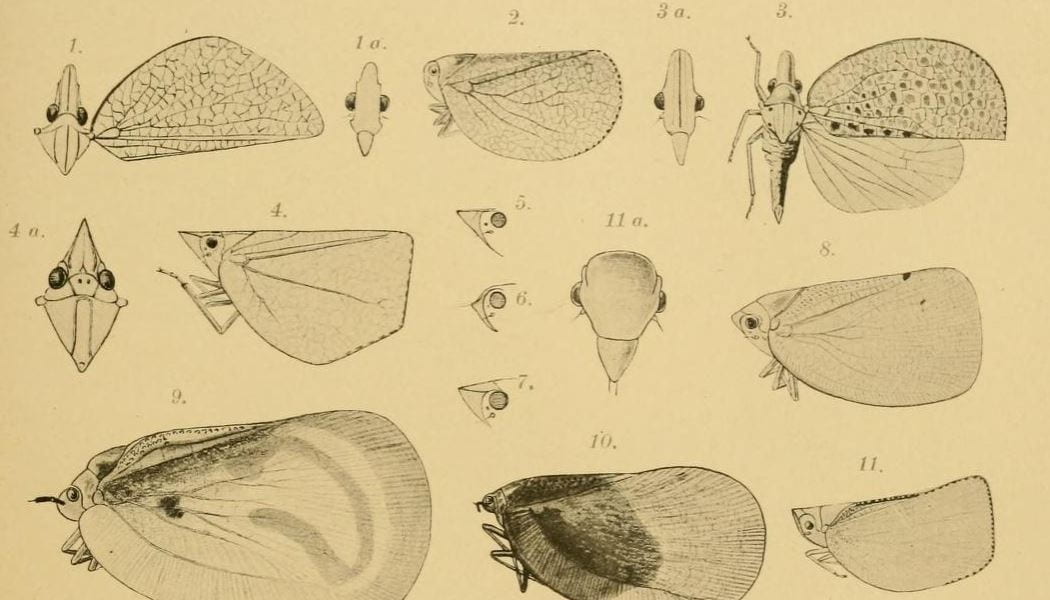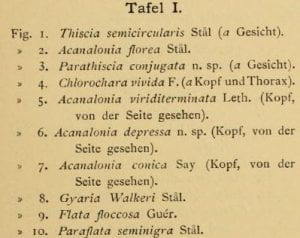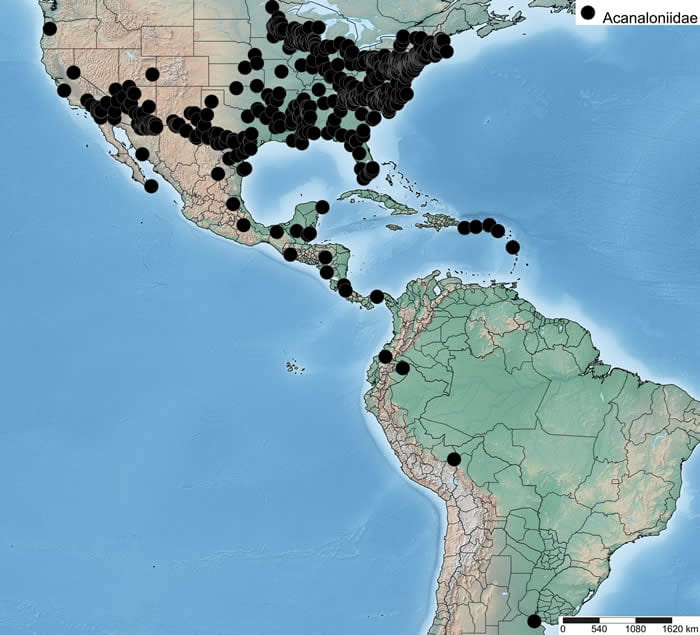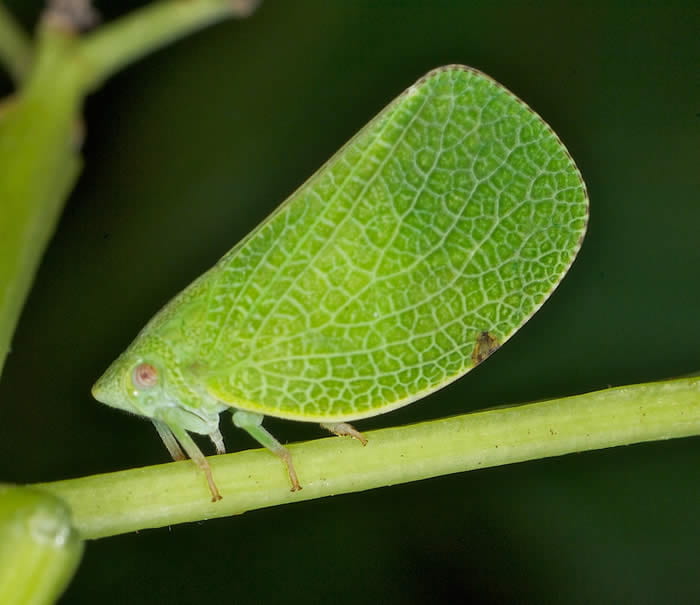
Acanalonia conica (Photo by Doug Tallamy, University of Delaware)
Acanaloniidae is a small family found entirely in the western hemisphere, consisting of 6 genera and 93 species. The family has undergone important changes in recent years. At the time of the Metcalf catalog (Metcalf 1954), the family included 13 genera, 81 species. Fennah (1954) subsumed Acanaloniidae into the Issidae and moved Euthiscia into Acanaloniidae (subsequently subsumed under Philatis by Gnezdilov 2012). The familial status of Acanaloniidae was reestablished by Emeljanov (1999), but he included Trienopinae and Tonginae from the Old World (following the suggestions of Muir 1930 & Fennah 1954). Since that time, Tonginae was transferred to Nogodinidae and Trienopinae to Tropiduchidae (Gnezdilov 2007, 2008). Notosimus Fennah, 1965, from Chile, was transferred to Acanaloniidae by Emeljanov (1999), confirmed by Gnezdilov (2019). The genus Aylaella Demir & Özdikmen, 2009 (from Madagascar) had until recently been placed in Acanaloniidae, but this genus was recently synonymized with Laberia Stål in the Tropiduchidae (Stroiński et al. 2022). Acanaloniidae is now understood to be strictly New World, with most species in the southwestern United States and Mexico, although the family ranges from southern Canada to Argentina and Chile, with species in the Caribbean and the Galapagos. Acanalonia conica is adventive in Europe (D’Urso & Uliana 2004, 2006; Nicoli Aldini et al. 2006) and is becoming widespread (Trivellone et al. 2015, Chireceanu et al. 2017, Seljak 2018, Pelozuelo et al. 2020, Holzinger et al. 2020, etc.). Acanalonia bivittata has recently been found in Italy (Sanna & Poggi 2022). Acanalonia excavata is adventive in southern Florida, evidently from Nicaragua (Halbert 1997, 2000; Halbert et al. 2007).
Acanaloniidae north of Mexico consists of 2 genera and 20 species, including 1 species of Philatis and 19 species of Acanalonia. The highest diversity is in the southwestern US and adjacent Mexico. The family is apparently absent from the northwest US (except for recent reports of Acanalonia conica).
Recognition
Acanaloniidae in North America can be recognized by having broad wings with irregular reticulate venation, carried parallel to the body in repose, and lacking the parallel crossveins in the costal area and claval wax pustules of flatids. Species of Acanalonia are usually green (in life), although there are aberrant pink individuals (and I have seen a light purple specimen, although I am uncertain of its species). The second hind tarsomere bears a pair of spines, a feature found in all higher Fulgoroidea, including Flatidae and Issidae, the families most superficially similar to Acanaloniidae. Acanaloniids lack lateral spines on the hind tibiae found in Issidae and the former Gaetuliini (now Elicini, Tropiduchidae).
Keys to species for Acanalonia species can be found in Doering (1932) and Freund & Wilson (1995).
Biology
Acanaloniids are feeders on woody and semi-woody plants, with both adults and nymphs on above-ground portions of plants, and a single generation per year in the studied species. The life history of Acanalonia conica and A. bivittata was described by Wilson & McPherson (1981b). Host plants and immatures of A. pumila were described by Wheeler & Hoebeke (1982).
Classification
At present, the higher classification of Acanaloniidae recognizes only 1 subfamily and tribe (Acanaloniinae, Acanaloniini).
Key to genera north of Mexico
1. Brown; vertex strongly anteriorly projecting; claval suture reaching to apical margin; uncommon, southwestern … Philatis Stal 1862
1’. Green (rarely pink); vertex usually truncate or rounded (in the U.S. except A. conica); claval suture usually not reaching apical margin; common and widespread … Acanalonia Spinola 1839
Key to genus modified from Melichar 1901: 182 (translated from German)
I have attempted to interpolate all acanaloniid taxa. I have not included the genus Notosimus Fennah, 1965 (with a single species Notosimus angustipennis (Melichar, 1906)), because I was not familiar with it at the time (but see Gnezdilov 2019).
The first couplet does not seem to work, and the status of Amphiscepa appears to be a problem.
1 Head straight truncated at the front; forehead [frons] wider than long, not keeled; species mostly tan, brown or yellowish. 1. Amphiscepa Say (Issidae)
[The status of Amphiscepa is unclear; see Melichar 1901: 182) [nec Amphiscepa Germar, this taxon sensu Say is jr syn of Acanalonia, syn appears to be by Van Duzee 1916: 81, see Metcalf 1954: 6, genus, according to Melichar 1901, has Acanalonia bivittata (Say 1825) as type. The type of Amphiscepa Germar is Amphiscepa nodipennis (Germar, 1821) from Brazil]
1— Head straight trimmed at the front, or angled at an acute angle or conical; color varied but many green species … 1a
1a. [still looking for a good feature] usually brown (Philatis signata is yellowish); hindwings rudimentary or absent; Galapagos, northwest coastal Mexico, west coast Ecuador, Peru … Philatis
1a- usually green (rarely pink); hindwings present; widespread … 2
2 Vertex straight, obtuse or triangular; forehead mostly keeled … 2a
2— Vertex strongly advanced, three to four times as long as between the eyes wide; the edges keeled … 3
2a In lateral view, face with shelf-like step, Caribbean (Cuba, Puerto Rico, Virgin Islands) … Bulldolonia Gnezdilov (see #6 in Melichar’s plate extracted below)
2a— face lacking shelf-like step in lateral view … Acanalonia Spinola
3 Vertex sharp acute-angled … 4
3— [Vertex] apex dull lanceolate, apex semicircular … 5
4 Vertex top flat. forewing at costal edge angled, rear straight trimmed. Pronotum with two lateral keels; Label [? ] with two approximated longitudinal keels … Chlorochara Stäl.
4— Vertex arched above; forewing rounded at the costal edge; pronotum without keels … Batusa Melichar
5 Vertex top flat. Cheeks pulled forward at an acute angle; forehead smooth; pronotum short … Thiscia Stäl. [This genus incertae sedis]
5— Vertex arched above, cheeks [gena] short; forehead with three keels; pronotum long … Parathiscia Melichar, 1901: 194. [this genus is now in the Tropiduchidae: Elicinae]]

Philatis tuberculata (Photograph by Kimberley Shropshire, Department of Entomology, University of Delaware).
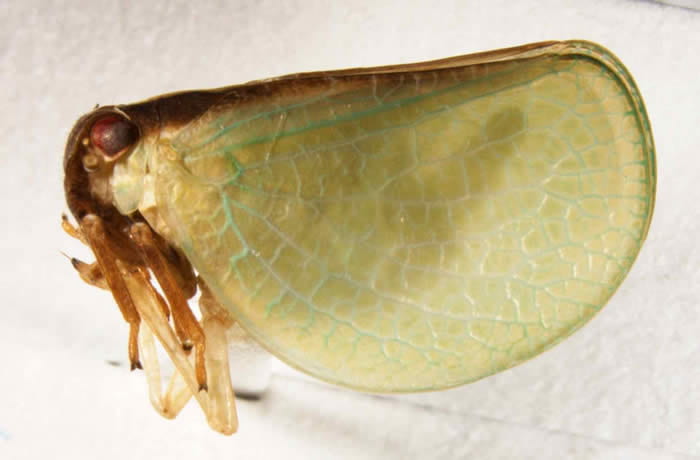
Acanalonia bivittata (Photograph by Kimberley Shropshire, Department of Entomology, University of Delaware).
Hind leg of Acanalonia conica showing absence of lateral spines
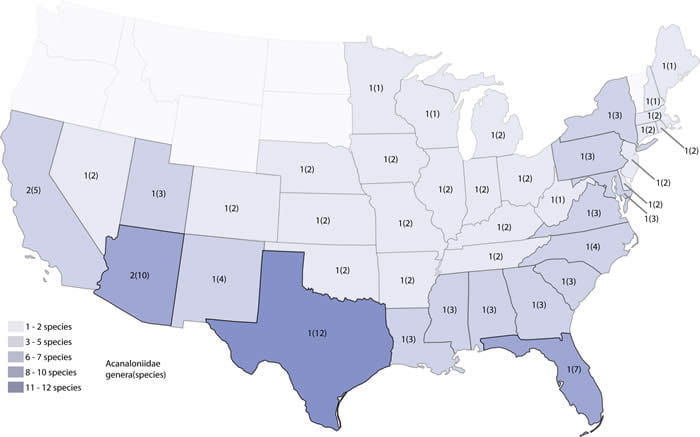
Distribution of species (genera) for Acanaloniidae in the US (From Bartlett et al 2014; 1 species also known from South Dakota).
Point-map of 2,188 georeferenced specimens of Acanaloniidae from the Tri-Trophic Thematic Collection Network database (as of Oct 2, 2015). The project emphasized specimens north of Mexico, which is why there are limited records in the Caribbean, Central and South America (I have seen specimens from Cuba, but the data on most of these simply reads “Cuba”).
Acanalonia Spinola, 1839 – Nearctic & Neotropics, ~62 species.
Batusa Melichar, 1901 (type species Acanalonia producta Stål, 1864).
Batusa agilis Melichar, 1901 – Puerto Rico (inc. subspp. maricensis Caldwell & Martorell 1951).
Batusa conata Melichar, 1901 – Brazil.
Batusa pinniformis (Fowler, 1900) – Mexico (Tabasco).
Batusa producta (Stål, 1864) – Mexico (Jalisco).
Bulldolonia Gnezdilov, 2012 (type species Acanalonia depressa Melichar, 1901).
Bulldolonia brevifrons (Muir, 1924) – Puerto Rico, St. Thomas, St. Croix, Anegada, Mona.
Bulldolonia depressa (Melichar, 1901) – Anegada, St. Croix, St. John, Jost Van Dyke Island (and “St. Jean”), Puerto Rico?.
Bulldolonia impressa (Metcalf & Bruner, 1930) – Cuba.
Chlorochara Stål, 1869 (type species Cicada vivida Fabricius, 1775; subsumed under Acanalonia by Caldwell & Martorell, 1951, but genus elsewhere recognized as valid (e.g., Metcalf 1945: 39, Gnezdilov 2012a, Bourgoin 2022).
Chlorochara vivida (Fabricius, 1775) Puerto Rico, Cuba, Suriname
Chlorochara vivida avivida (Caldwell, 1951) – Puerto Rico
Chlorochara vivida coniceps (Osborn, 1929) – Puerto Rico, Caja de Muertos Island
Notosimus Fennah, 1965 (Monotypic)
Notosimus angustipennis (Melichar, 1906) – Chile
Philatis Stål, 1862, 11 species, mostly Galapagos (but the type specimens of the type species, Mycterodus productus Stål, 1859: 277, is evidently from the coast of Peru).
= Galapagosana Distant, 1909; synonym by Gnezdilov (2012: 645).
= Euthiscia Van Duzee, 1923; synonym by Gnezdilov (2012: 645).
Thiscia Stål, 1862 (type species Thiscia semicircularis Stål, 1862). (transferred to Fulgoroidea incertae sedis by Gnezdilov 2012: 645)
Thiscia jaraguensis Schmidt, 1932 – Brazil (Santa Catarina).
Thiscia melichari Schmidt, 1932 – Brazil (Rio de Janeiro).
Thiscia ohausi Schmidt, 1932 – Brazil (Sao Paulo).
Thiscia semicircularis Stål, 1862 – Brazil (Rio de Janeiro).
Genera now excluded from Acanaloniidae
The following genera were transferred to Tropiduchidae (Elicinae) by Gnezdilov (2013)
Hemithiscia Schmidt, 1912: 95 – Africa, 3 species.
= Thinea Melichar, 1914
Paraphilatis Melichar, 1912 – Africa, 1 species.
Parathiscia Melichar, 1901 – Africa, 2 species.
Pseudothiscia Schmidt, 1912: 93 – Africa, 1 species.
The following genus was in Acanaloniidae but is now in Tropiduchidae (Laberiini) :
Aylaella Demir & Özdikmen, 2009 – Madagascar, 1 species.
= Perinetia Lallemand & Synave, 1954 (preoccupied).

Type specimen of Euthiscia signata (now in Philatis)
Philatis breviceps Van Duzee, 1933 (image courtesy Mike Wilson, National Museum of Wales; specimen collected by Charles Darwin)
References
Amyot, C.J.B. and J.G. Serville. 1843. Deuxième partie. Homoptères. Homoptera Latr. Histoire Naturelle des insectes. Hemiptères 1843: 1-676.
Bartlett, C.R. 2000. An annotated list of planthoppers (Hemiptera: Fulgoroidea) of Guana Island (British West Indies). Entomological News 111(2): 120-132.
Bartlett, C.R., L. B. O’Brien and S. W. Wilson. 2014. A review of the planthoppers (Hemiptera: Fulgoroidea) of the United States. Memoirs of the American Entomological Society 50: 1-287.
Bourgoin, T. 2025. FLOW (Fulgoromorpha Lists on The Web): a world knowledge base dedicated to Fulgoromorpha. Version 8, updated [date]. https://flow.hemiptera-databases.org/flow/ (updated 2024-01-04).
Caldwell, J. S. 1947b. New Acanaloniidae from Mexico. (Homoptera). Bulletin of the Brooklyn Entomological Society 41: 164-165.
Caldwell, J.S. and L.F. Martorell. 1951. Review of the Auchenorynchous [sic] Homoptera of Puerto Rico. Part II. The Fulgoroidea except Kinnaridae. Journal of Agriculture of the University of Puerto Rico (1950) 34(2): 133-269.
Campodonico, J.F. 2020. Primer registro de un Acanaloniidae (Hemiptera: Auchenorrhyncha: Fulgoroidea) en Chile [First record of an Acanaloniidae (Hemiptera: Auchenorrhyncha: Fulgoroidea) in Chile]. Revista de la Sociedad Entomológica Argentina 79(1): 34-36. http://doi.org/10.25085/rsea.790106
Chireceanu, C., A. Teodoru, M. Gutue, M. Dumitru & P. Anastasiu. 2017. Two new invasive hemipteran species first recorded in Romania: Orientus ishidae (Matsumura 1902) (Cicadellidae) and Acanalonia conica (Say 1830) (Acanaloniidae). Journal of Entomology and Zoology Studies 5(2): 824-830.
Clément, V. 2024. Première observation du fulgore exotique Acanalonia conica (Say, 1830) (Hemiptera, Fulgoromorpha, Acanaloniidae) en Alsace (France, Grand Est, Haut-Rhin). Bulletin de la Société d’Histoire naturelle et d’Ethnographie de Colmar 80(5): 21-23.
D’Urso, V. and M. Uliana. 2004. First record of Acanalonia conica (Issidae) in Italy. Third European Hemiptera Congress, Abstracts, St. Petersburg, Russia, 8-11 June 2004: 26-27.
D’Urso, V. and M. Uliana. 2006. Acanalonia conica (Hemiptera, Fulgoromorpha, Acanaloniidae), a Nearctic species recently introduced in Europe. Mitteilungen aus dem Museum für Naturkunde in Berlin, Zoologische Reihe 53(1): 103–107.
Demir, E. and H. Özdikmen. 2009. Two New Replacement Names for Genera in Dictyopharidae and Acanaloniidae (Hemiptera: Auchenorrhyncha). Proceedings of the Entomological Society of Washington 111(1): 271.
den Bieman, C.F.M.K., M.C.M. de Haas, and T. Fens-Bax. 2024. Twee exotische cicaden nieuw voor Nederland: Acanalonia conica en Pochazia shantungensis (Fulgoromorpha: Acanaloniidae & Ricaniidae). Nederlandse Faunistische Mededelingen 62: 63-70.
Distant, W.L. 1909. Rhynchotal notes xiviii. Annals and Magazine of Natural History (Ser. 8) 4: 73-87.
Doering, K.C. 1932. The genus Acanalonia in America north of Mexico (Fulgoridae, Homoptera). Annals of the Entomological Society of America 25: 758‑786.
Emeljanov, A.F. 1999. Notes on delimitation of families of the Issidae group with description of a new species of Caliscelidae belonging to a new genus and tribe (Homoptera, Fulgoroidea). Zoosystematica Rossica 8: 61-72.
Fennah, R.G. 1949. On a small collection of Fulgoroidea (Homoptera) from the Virgin Islands. Psyche 56(2): 51-65.
Fennah, R.G. 1954. The higher classification of the family Issidae (Homoptera: Fulgoroidea) with descriptions of new species. Transactions of the Royal Entomological Society of London 105: 455‑474.
Fennah, R.G. 1965. Fulgoroidea from Southern Chile (Hemiptera). Bulletin of the British Museum (Natural History). Entomology 17(6): 233-272 [264].
Freund, R. and S.W. Wilson. 1995. The planthopper genus Acanalonia in the United States (Homoptera: Issidae) morphology of male and female external genitalia. Insecta Mundi 9: 195-215.
Gjonov, I., T. Tsvetanov, and R. Angelova. 2024. New record of Orientus ishidae (Matsumura, 1902) (Hemiptera: Cicadellidae) in Bulgaria with notes on the distribution of Acanalonia conica (Say, 1830) (Hemiptera: Acanaloniidae). Historia Naturalis Bulgarica 47(2): 27-32. https://doi.org/10.48027/hnb.47.021.
Gjonov, I., M. Pramatarova, E. Hizal, and S. Öztemiz. 2023. Acanalonia conica (Hemiptera, Acanaloniidae)–a new exotic species in Bulgaria and Türkiye and its expansion in Europe. Travaux du Muséum National d’Histoire Naturelle “Grigore Antipa” 66(1): 7-15. https://doi.org/10.3897/travaux.66.e101161.
Gnezdilov, V.M. 2007. On the systematic positions of the Bladinini Kirkaldy, Tonginae Kirkaldy, and Trienopinae Fennah (Homoptera, Fulgoroidea). Zoosystematica Rossica 15: 293-297.
Gnezdilov, V.M. 2008. To the taxonomy of higher Fulgoroidea. Bulletin of Insectology 61: 119-120.
Gnezdilov, V.M. 2012a. On the composition and distribution of the family Acanaloniidae Amyot et Serville (Homoptera, Fulgoroidea). Entomologicheskoe obozrenie 91(3): 157–161. [In Russian, English translation Entomological Review (2013) 93(1): 69-72.]
Gnezdilov, V.M. 2012b. On the taxonomy of some Fulgoroidea (Hemiptera). Proceedings of the Zoological Institute RAS 316(3): 239-247.
Gnezdilov, V.M. 2012c. A new genus of the family Acanaloniidae (Homoptera: Fulgoroidea) from the Caribbean Basin. Zoosystematica Rossica 21(2): 302-305.
Gnezdilov, V.M. 2013. Contribution to the taxonomy of the family Tropiduchidae Stl (Hemiptera, Fulgoroidea) with description of two new tribes from Afrotropical Region. Deutsche entomologische Zeitschrift 60(2): 179-191.
Gnezdilov, V.M. 2019. On the taxonomic position of Notosimus angustipennis (Melichar, 1906) (Hemiptera: Auchenorrhyncha: Fulgoroidea: Acanaloniidae). Proceedings of the Zoological Institute RAS 323(2): 112-119.
Halbert, S.E. 1997. Entomology section. TRI-OLOGY 36(3), May-June, 1997: 3-11.
Halbert, S.E. 2000. Entomology section. TRI-OLOGY 39(3), May-June, 2000 (http://www.freshfromflorida.com/pi/enpp/triology/archive/00-may-jun.html#ent).
Halbert, S.E., L.B. O’Brien and S.W. Wilson. 2007. The planthopper genus Acanalonia in Florida with notes on a recently introduced species, A. excavata (Hemiptera: Fulgoroidea: Acanaloniidae). Florida Entomologist 90: 690-692.
Holzinger, W., E. Huber, L. Schlosser & G. Kunz. 2020. Acanalonia conica (Say, 1830) and three other true hopper species new for Austria (Hemiptera: Auchenorrhyncha). Cicadina 19: 9-19. https://doi.org/10.1556/038.2021.00132
Jansky, V., J. Kollár, and M. Barta. 2021. Prvé Nálezy Cikádok Acanalonia conica (Say, 1830) a Graphocephala fennahi Young, 1977 (Auchenorrhyncha, Acanaloniidae A Cicadellidae) na Slovensku. Acta Rerum Naturalium Musei Nationalis Slovaci Bratislava 67: 117-124.
Kóbor, P., E. Kondorosy, C. Nagy, and A. Orosz. 2021. Acanalonia conica (Say, 1830): A new alien planthopper species established in Hungary (Auchenorrhyncha: Fulgoroidea: Acanaloniidae). Acta Phytopathologica et Entomologica Hungarica 56(2): 201-207. https://doi.org/10.1556/038.2021.00132.
Lallemand, V. and H. Synave. 1954. Homoptères nouveaux de Madagascar. Le Naturaliste Malgache 6: 79-82. [Perinetia reticulata Lallemand & Synave, 1954 new genus and species, genus preoccupied, replaced by Aylaella Demir & Özdikmen, 2009].
Maryanska-Nadachowska A., V.G. Kuznetsova, V.M. Gnezdilov, and Drosopoulo. 2006. Variability in the karyotypes, testes and ovaries of planthoppers of the families Issidae, Caliscelidae, and Acanaloniidae (Hemiptera: Fulgoroidea). European Journal of Entomology 103(3): 505–513.
Melichar, L. 1901. Monographie der Acanaloniiden und Flatiden (Homoptera). Annalen des k.k Naturhistorischen Hofmuseums 16: 178-258.
Melichar, L. 1914. Homoptera. Pp. 109-134 + 2 figs. In: Wissenschaftliche Ergebnisse der zweiten Deutschen Zentral-Afrika-Expedition 1910-1911 unter Führung Adolph Friedrichs, Herzog zu Mecklenburg, (1912, vol. 1). Leipzig, Klinkhardt & Biermann 1913-1925.
Metcalf, Z.P. 1954. General catalogue of the Homoptera. Fascicle IV. Fulgoroidea, Part 14. Acanaloniidae. North Carolina State University, Raleigh, NC. 55 pp.
Muir, F.A.G. 1930c. On the classification of the Fulgoroidea. Annals and Magazine of Natural History (Series 10) 6: 461-478.
Nicoli Aldini, R., E. Mazzoni and M. Ciampitti. 2006. Ritrovamento della cicalina neartica Acanalonia conica (Say) (Rhynchota Fulgoromorpha Acanaloniidae) in Lombardia (Italia settentrionale). Bollettino di Zoologia agraria e di Bachicoltura II. 38(3): 261-264.
Osborn, H. 1935a. Insects of Porto Rico and the Virgin Islands. Homoptera (excepting the Sternorhynchi). Scientific Survey of Porto Rico and the Virgin Islands 14: 111-260.
Pechuman, L.L. and A.G. Wheeler, jr. 1981. Northern range extension of Acanalonia conica (Homoptera: Acanaloniidae). Entomological News 92: 98‑100.
Pelozuelo, L., T. Bourgoin & P. Reynaud. 2020. A new alien species in France: first records of the green cone-headed planthopper Acanalonia conica (Say, 1830) (Hemiptera, Fulgoromorpha, Acanaloniidae). Bulletin de la Société Entomologique de France 125(4): 423-426.
Sanna, F. and F. Poggi. 2022. First record of three alien Auchenorrhyncha species from Europe: Acanalonia bivittata (Say, 1825), Branchana xanthota Li, 2011, and Dryadomorpha pallida Kirkaldy 1906 (Hemiptera: Auchenorrhyncha: Acanaloniidae, Cicadellidae). Zootaxa 5194(2). https://doi.org/10.11646/zootaxa.5194.2.8.
Schmidt, E. 1912. Diagnosen neuer Fulgoriden-Gattungen und Arten nebst einigen bemerkungen. Entomologische Zeitung. Herausgegeben von dem entomologischen Vereine zu Stettin 73: 67-102.
Schmidt, E. 1932. Neue und bekannte Zikadengattungen und Arten der neuen Welt . (Hemipt.-Homopt.). Entomologische Zeitung. Herausgegeben von dem entomologischen Vereine zu Stettin 93: 35-54.
Seljak, G. 2018. Notable new findings of Auchenorrhyncha (Hemiptera) in Slovenia. Acta Entomologica Slovenica 26(2): 181-194.
Spinola, M. 1839. Essai sur les Fulgorelles, sous-tribu de la tribu des Cicadaires, ordre des Rhyngotes. (Suite). Annales de la Société Entomologique de France. Paris 8: 339-454 [p. 447, Acanalonia described].
Stål, C. 1862. Bidrag till Rio de Janeiro-tratkens Hemipterfauna.II. Handlingar. Kongliga Svenska Vetenskaps Akademien 3(6): 1-75.
Stål, C. 1869. Hemiptera Fabriciana. Fabricianska Hemipterarter, efter de Köpenhamn och Kiel förvarade typexemplaren granskade och beskrifne. 2. Handlingar. Kongliga Svenska Vetenskaps Akademien 8(1): 1-130.
Stroiński, A., T. Bourgoin, & J. Szwedo. 2022. Laberiini, a new tribe of Tropiduchidae planthoppers from Madagascar (Hemiptera: Fulgoroidea). European Journal of Taxonomy 836(1): 23-54. https://doi.org/10.5852/ejt.2022.836.1913
Trivellone, V., E. Knop, T. Turrini, A. Andrey, J.Y. Humbert and G. Kunz. 2015. New and remarkable leafhoppers and planthoppers (Hemiptera: Auchenorrhyncha) from Switzerland. Mitteilungen der Schweizerischen Entomologischen Gesellschaft 88: 273-284.
Van Duzee, E.P. 1923. Expedition of the California Academy of Sciences to the Gulf of California in 1921 – The Hemiptera (True Bugs, etc.). Proceedings of the California Academy of Sciences (Ser. 4) 12: 123-200.
Van Duzee, E.P. 1933. The Templeton Crocker Expedition of the California Academy of Sciences, 1932, No. 4. Characters of twenty-four new species of Hemiptera from the Galapagos Islands and the coast and islands of Central America and Mexico. Proceedings of the California Academy of Sciences (Series 4) 21: 25-40.
Wheeler, A.G., jr. and E.R. Hoebeke. 1982. Host plants and nymphal descriptions of Acanalonia pumila and Cyarda sp. near acutissima (Homoptera, Fulgoroidea: Acanaloniidae and Flatidae). Florida Entomologist 65(3): 340-349.
Wilson, M.R., M.F. Claridge, S.C. Shackel and L. Dalbeck. 1997 Speciation by Issidae (Fulgoroidea) in the Galapagos islands: how many Philatis species are there? Pp. 37. In: M.J. Fletcher, M.F. Day, P.S. Gillespie, M.M. Stephens and M.S. Moulds (eds.). Program and Abstract Book, 9th International Auchenorrhyncha Congress, Sydney, Australia, 17–21 February 1997. 76 pp.
Wilson, S.W. and J.E. McPherson. 1981. Life histories of Acanalonia bivittata and A, conica with descriptions of immature stages. Annals of the Entomological Society of America 74: 289-298.
last edit 27 Sept. 2025

